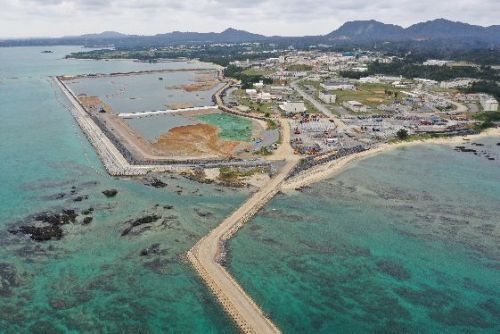Embankment to be built for new Henoko base could collapse, weak ground fails to meet national port facility standards

The coast of Henoko where land reclamation work for the new base construction is underway, in January 2020
February 17, 2020 Ryukyu Shimpo
Regarding the issue that data existed indicating the presence of “weak” ground deeper than 70 meters below the sea surface at the location of the new base construction in Henoko, Nago, Niigata University emeritus professor of geology Masaaki Tateishi and his survey team performed their own investigation of the stability of a planned embankment on the basis of this data. On February 16, it was learned that their investigation indicated the result that in a worst-case scenario, the embankment could collapse.
The Ministry of Defense asserts that there is no need to re-survey the ground strength at this deep location, but Professor Tateishi says, “[the government] should perform another survey and publicize the data.”
The data in question relates to the strength of the ground at the “B27” location where installation of a large concrete embankment is planned, and comes from a survey carried out by a contractor hired by the Ministry of Defense.
According to Professor Tateishi, when he and his team analyzed the stability of the ground using this data, the stability did not satisfy the standard for port facilities designated by the Ministry of Land, Infrastructure, Transport and Tourism, and the analysis yielded the result that the large embankment planned to be installed on this ground would have a risk of collapse.
The Ministry of Defense did not reflect this data in its design on the grounds that the contractor merely performed an independent and simple survey and the reliability of the data was low.
At a news conference on February 14, Defense Minister Taro Kono stated that the survey resulting in the data “is not something that can be called a mechanical test [for finding the strength].”
The Ministry of Defense has concluded that the strength of the ground at the deep B27 location is “extremely hard” based on mechanical tests performed at three spots ranging from 150 to 750 meters away from the B27 location.
The Ministry of Defense plans to submit an application to Okinawa Prefecture next month regarding plan changes required to carry out improvement work on the weak sea floor.
The ministry asserts that another survey of the B27 location is “unnecessary” (Minister Kono) on the grounds that the ministry’s technology investigation committee, composed of experts in the field, has carried out thorough discussion on the matter.
Professor Tateishi’s survey team is composed of around a dozen experts in geology-related fields.
Based on geological surveys, it has also raised such issues as the high likelihood that an active fault is present at the planned site of construction of the new Henoko base.
(English translation by T&CT and Sandi Aritza)
Previous Article:Hayato Sonoda wins the Okinawa marathon men’s race, Karen Kinjo wins the women’s race
Next Article:A reduction in tourist visitors to Okinawa due to coronavirus, anticipated to be around 500,000, could lead to a decrease in tourism revenue of 28.1 billion yen, cause 1,940 job losses
[Similar Articles]
- Explanatory documents on soft seabed from MOD commission contained 20 mistakes
- Research group finds that earthquake with seismic intensity of 1 may collapse Henoko seawalls
- MOD cites research agency contract as reason for not releasing February dugong call recording
- Okinawa Defense Bureau confirms traces of dugongs eating seaweed in the sea around Henoko
- Expert claims no previous reinforcement of soft ground 90 meters below sea level, the depth found in Henoko construction area
 Webcam(Kokusai Street)
Webcam(Kokusai Street)


